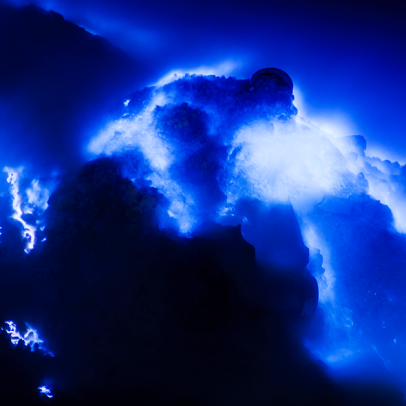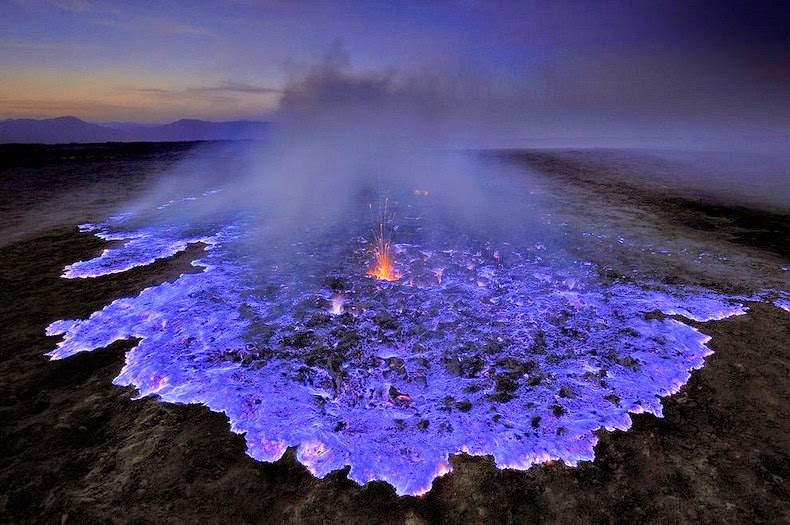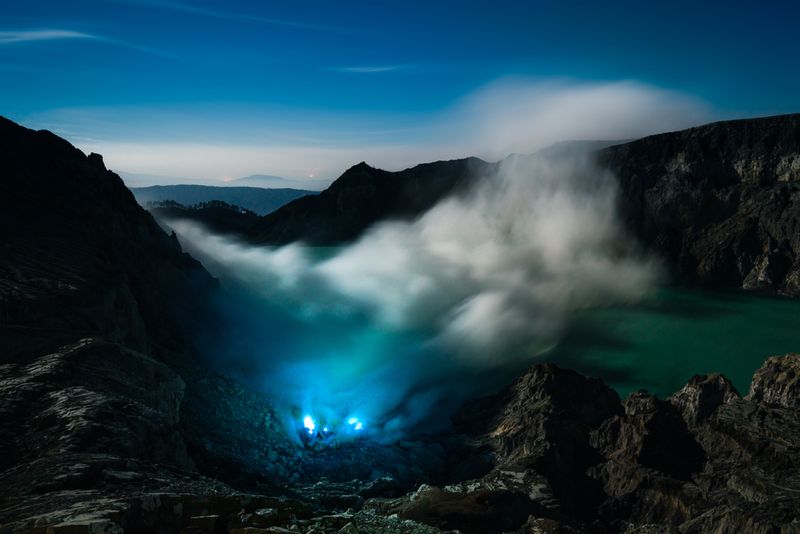The Blue Lava at Kawah Ijen Volcano in Indonesia is a mesmerizing natural phenomenon. It occurs due to sulfur combustion at high temperatures.
Kawah Ijen Volcano, located in East Java, Indonesia, is famous for its stunning blue lava. This captivating blue glow is not actual lava but the result of burning sulfur gases. When these gases escape from the cracks in the volcano and ignite, they produce a bright blue flame.
The best time to witness this rare spectacle is during the night when the blue flames are most visible. Tourists from around the globe trek to this site for a once-in-a-lifetime experience. Remember to wear a gas mask, as the sulfur fumes can be harmful.

Mysteries Of Kawah Ijen’s Blue Lava
Kawah Ijen is famous for its blue lava. This blue color is not actual lava. It is the result of burning sulfur gases. These gases emerge from cracks in the volcano. They ignite when they meet the air. The flames can reach up to 5 meters high. At night, the glow is most visible. This creates a stunning blue effect.
| Characteristic | Blue Lava | Red Lava |
|---|---|---|
| Color | Blue | Red |
| Cause | Burning sulfur gases | Molten rock |
| Visibility | Best at night | Visible at all times |
Kawah Ijen Volcano
Kawah Ijen Volcano is in East Java, Indonesia. It is part of the Ijen volcano complex. This area is known for its mining activities. It is surrounded by lush forests and rugged terrain. The volcano is a famous tourist spot. Many people visit to see the blue lava.
Kawah Ijen has erupted several times in history. The first recorded eruption was in 1796. The most recent eruptions happened in the 20th century. These eruptions have shaped the landscape. Each event has left behind a unique geological footprint. Despite the eruptions, the area remains popular.
The Science Behind The Blue Flames
Blue lava comes from sulfuric gases. These gases escape from cracks in the volcano. They ignite when they reach the air. This creates the stunning blue flames. The flames can reach temperatures of up to 600°C. This is much hotter than normal lava. Sulfur burns with a blue flame, unlike typical orange lava.
Temperature affects the color of the flames. Higher temperatures produce blue flames. Lower temperatures produce red or orange flames. The blue color is due to the high temperature of the burning sulfur. This makes the flames look otherworldly. The blue flames are best seen at night.
Exploring The Sulfur Mining At Kawah Ijen
The miners at Kawah Ijen work in tough conditions. They carry heavy loads of sulfur on their backs. Each load can weigh as much as 70 kilograms. The air is filled with toxic gases. Miners have to wear masks to breathe. They work long hours for very little pay. Their health often suffers because of the harsh environment. Many miners develop respiratory problems. Despite the risks, they keep working to support their families. Their dedication is truly remarkable.
Sulfur mining at Kawah Ijen boosts the local economy. It provides jobs for many people. The sulfur is sold to various industries. These industries use sulfur in products like fertilizers and batteries. The money earned helps improve living conditions. It supports local businesses and schools. Even though the work is hard, it is crucial for the community. The economic benefits are significant for the region.
Photographing Kawah Ijen’s Blue Lava
The best time to capture the blue lava is at night. The blue flames are visible in the dark. Arrive at Kawah Ijen before sunset. This gives you time to set up. The blue lava is most vibrant in the early hours. The best shots are taken around midnight. Use a tripod to keep your camera steady. Long exposure settings help capture the glow.
Wear a gas mask to protect from sulfur fumes. The gases can be harmful. Bring a flashlight for navigating in the dark. The paths can be steep and rocky. Stay with a group for added safety. Follow the marked trails and signs. Avoid getting too close to the lava. The area can be slippery and dangerous. Always listen to local guides.
Environmental Impacts Of The Blue Lava
The blue lava at Kawah Ijen is beautiful but dangerous. It affects the local wildlife in many ways. Birds and small animals can get too close and get burned. They may also breathe toxic gases from the volcano. This makes it hard for them to survive.
The volcano releases sulfur gases into the air. These gases can harm humans and animals. People living nearby may have trouble breathing. They might need to wear masks for safety. The air quality is often very poor near the volcano.
The Local Lore Surrounding Kawah Ijen
Many myths surround Kawah Ijen. One popular story tells of a dragon. This dragon lives beneath the volcano. Locals believe it guards a secret treasure. Another legend speaks of a spirit. This spirit protects the miners. People say the blue lava is magical. It is a gift from the volcano gods. These tales have been told for generations.
Kawah Ijen holds cultural importance. It is more than just a volcano. Locals use its sulfur for trade. The volcano supports many families. Its blue flames attract tourists. This boosts the local economy. The site is sacred to many. Rituals are held to honor the volcano. It is a symbol of nature’s power and beauty.
Visiting Kawah Ijen Volcano
Kawah Ijen Volcano is a unique place. It has blue lava that glows at night. Good preparation is key for this trek. Wear comfortable and sturdy shoes. Bring warm clothing since it gets cold. A flashlight is essential for the dark paths. Don’t forget to carry enough water and snacks. Ensure you have a gas mask. The sulfur fumes can be strong.
Guided tours offer safety and knowledge. Guides know the terrain well. They can share interesting facts. Tours usually provide gas masks. They also help in case of emergencies. On the other hand, solo explorations offer more freedom. You can move at your own pace. Solo trips can be more adventurous.
Conservation Efforts At The Site
The Blue Lava at Kawah Ijen is a rare sight. Conservationists work to protect this natural wonder. They monitor the volcanic activity closely. This helps to keep the area safe. They also educate the public about its importance. Visitors learn how to respect the site. This reduces damage to the environment.
Sustainable tourism is key to preserving Kawah Ijen. Tourists are encouraged to follow guidelines. They should avoid littering and stick to marked paths. This helps protect the fragile ecosystem. Local guides offer tours that educate visitors. These tours promote awareness and respect for nature. By following these practices, we can enjoy Kawah Ijen for years to come.

Comparative Analysis Of Volcanic Wonders
Kawah Ijen is famous for its blue lava. This happens because of the sulfur in the area. The blue flames are bright and magical. Other volcanoes also have unique features. Some have lava lakes or frequent eruptions. Each volcano has its charm and danger.
Volcanoes are found in many countries. Mount Etna in Italy is very active. Mount Fuji in Japan is a symbol of beauty. Yellowstone in the USA has geysers and hot springs. Each site attracts many visitors. Nature’s power is seen in these places.

Conclusion
Witnessing the blue lava at Kawah Ijen Volcano is a truly mesmerizing experience. This natural wonder draws adventurers and photographers alike. Visiting this Indonesian marvel offers a unique glimpse into nature’s rare phenomena. Plan your trip to Kawah Ijen and experience the breathtaking blue flames for yourself.






